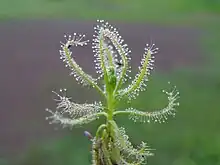Drosera indica
Drosera indica is an insectivorous plant, a sundew native to tropical countries throughout the world, from Asia to Africa, but absent from the neotropics.[1] Together with Australian endemic species D. aquatica, D. aurantiaca, D. barrettorum, D. cucullata, D. finlaysoniana, D. fragrans, D. glabriscapa, D. hartmeyerorum, D. nana, D. serpens it makes up the section Arachnopus.[2]
| Drosera indica | |
|---|---|
_in_Narsghapur%252C_AP_W_IMG_0951.jpg.webp) | |
| D. indica in Narsapur, Medak district, India | |
| Scientific classification | |
| Kingdom: | Plantae |
| Clade: | Tracheophytes |
| Clade: | Angiosperms |
| Clade: | Eudicots |
| Order: | Caryophyllales |
| Family: | Droseraceae |
| Genus: | Drosera |
| Subgenus: | Drosera subg. Drosera |
| Section: | Drosera sect. Arachnopus |
| Species: | D. indica |
| Binomial name | |
| Drosera indica | |

Description
Drosera indica is an unbranched, annual herbaceous plant, supported by a fibrous root system and reaching a height of 5–50 cm (2–20 in). Leaves are narrowly linear, up to 10 cm [4 in] long with 1–1.5 cm [0.4–0.6 in] pedicels.[3] Young plants stand upright, while older ones form scrambling stems with only the newest growth exhibiting an upright habit. The plant can be yellow-green to maroon in color. Flower petals can be white, pink, orange, or purple.[3] Its chromosome count is 2n=28.[4]
References
- Schlauer, J. 2011. World Carnivorous Plant List – Nomenclatural Synopsis of Carnivorous Phanerogamous Plants. Retrieved 30 March 2011.
- Barret and Lowrie, 2013. Application of names in Drosera section Arachnopus (Droseraceae). Retrieved 15 November 2017.
- Lowrie, Alan. 1998. Carnivorous Plants of Australia, volume 3. University of Western Australia Press. p. 180.
- Kondo, K. 1969. Chromosome numbers of carnivorous plants. Bulletin of the Torrey Botanical Club, 96(3): 322–328.
